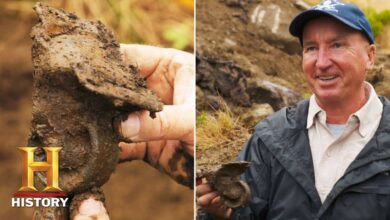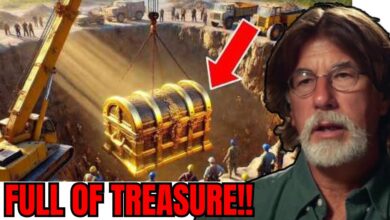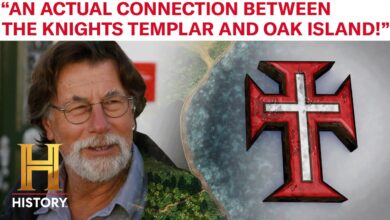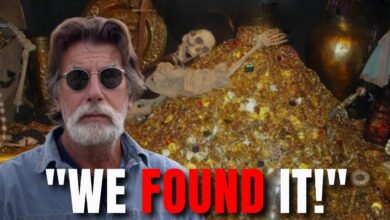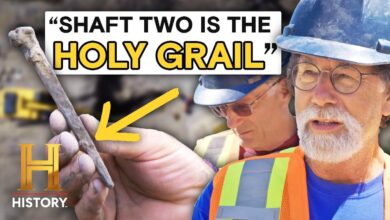The Curse of Oak Island: A Huge Breakthrough Gets Marty Excited (Season 6) | History
The Curse of Oak Island: A Huge Breakthrough Gets Marty Excited (Season 6) | History

NARRATOR: OR: At the
College of Art and in the city of Halifax,
Begley, Charles Bark, and Doug Crowell are at the
basement of the place where Oak Island’s
90-foot stone was seen more than 100 years ago.
According to reports,
the so-called 90-foot stone was taken to the city
of Halifax in 1860, where it was put on display
in the window of the Cn and Marshall’s
Bookstore in an effort to draw investors to
Oak Island treasure.
But when the combined bookstore and book
bindery closed in 1919, the stone seemed
to vanish without a trace.
“I think we’ve found it,”
Look at that.
Man, if that isn’t two feet, I don’t know what is.
Does it have any markings on it?
Oh, look, there’s something cut…
[inaudible].
There’s a couple, by the looks of it.
Charles, it looks to me like an L.
L-N. This may be the one.
Let’s get this up on the table.
All right, you ready?
Yeah, I’m ready.
Here we go.
The reason why we actually brought in a
rental unit—
- Hi, guys.
- Hey.
- Hey.
- What the hell are you lugging in here?
- We’ve got a little something to show.
Wow.
It doesn’t look very…
- Little something?
- A little something.
- Holy smokes.
[music playing]
Well, gentlemen,
this particular stone came from the book
bindery in Halifax.
It was in a crawlspace in the NSCAD building,
right where it was supposed to be, in my opinion.
Because I do think this is the stone that Bowden
saw in the book bindery.
- Second, the 90-foot stone?
- The one—wait—
The supposed 90-foot?
Well, where’s all the inscription?
There was writing.
Right.
We wrote about it in 1919.
Remember what Bowden—
NARRATOR: In 1909, reports
that the 90-foot stone was on display in a
Halifax bookstore.
Oak Island treasure hunter Captain
Henry L. Bowden traveled there to see it first.
He was hoping that,
after carefully examining the
carved symbols and markings,
he might be able to decipher clues in the stone
that had been previously overlooked.
Unfortunately,
when he arrived, he was horrified to discover
that the stone was being used as a slab for
beating and cutting leather,
and that years of rough handling from the
book binder’s press
had left the inscription so damaged
that it was almost completely worn away.
The only carvings Bowden could make out
were the initials L-N,
nothing similar to symbols that had earlier been recorded.
Bowden left the book bindery both
disappointed and empty.
Bowden said there were only two initials
left on it,
and if you look right there, gentlemen,
you see the two well-carved initials:
L-N??
Is this an L? L?
That’s right.
It has the appearance of L-N.
That’s interesting.
Yeah.
The stone weighs close to 200 pounds.
The statement said
it weighed around 200 pounds, didn’t it?
He said in his statement…
The other things about the stone were
that it was flat on two sides,
that it had round corners,
that it was about 10 inches thick,
about 15 inches wide,
and about 2 feet long.
The dimensions are almost exactly the same.
There appear to be some very faint cuts
in the face of the stone.
It could be the original.
It could be a huge breakthrough.
It’s exciting.
It’s just the beginning.
OK, well, do you know about Stonehenge?
They did some kind of laser and then they found
all kinds of ancient carvings that you
can’t see with the naked eye.
Is that right?
Mm-hmm-hmm.
NARRATOR: In 2002, a team of researchers from
Archaeology and Archaeology in Salisbury, England
conducted a high-tech examination of Stonehenge.
Using high-resolution scanners capable of registering
details as small as half a millimeter,
they discovered numerous carvings
that had been impossible to detect with the naked eye.
Could this same technology
help the team to recover the inscriptions
on the suspected 90-foot stone that could help
find the Oak Island treasure?
Can we have that done?
Can we see if we need to?
If that really is the stone, and if we can
use some technology and see the inscriptions,
I’m gonna be pretty excited.




